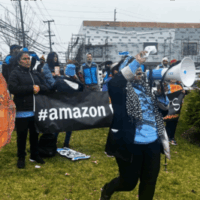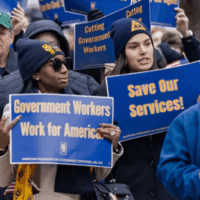In March 2020, the economy grinded to a halt as the COVID-19 pandemic forced widespread shutdowns of businesses. As Congress watched the economy collapse, it responded by doing something lawmakers have resisted since the 1960s: a large expansion of the social safety net.
Emergency paid sick and family leave, modernizing and expanding unemployment insurance, monthly tax payments to families with children and expanded health care access all were passed during the emergency. In turn, it rescued families and the U.S. economy from a crash that could’ve rivaled the Great Depression.
But these programs were temporary. President Joe Biden tried to extend them through his Build Back Better agenda, but Congress failed to find the votes. Now, activists are pressing to foster the permanent return of these benefits.
‘It kept families from sinking’
Piper Stiles, a single mother of a 10-year-old, worked jobs that shut down early in the pandemic, so she relied on expanded unemployment benefits, which she called a huge help. When the monthly expanded child tax credit payments started coming in July 2021, the Maine resident paid off debt that improved her credit rating, and used payments to open a savings account for her daughter. It wasn’t life changing, but it provided optimism.
“Could this be sort of an inoculant for our culture,” she said, “to (be) willing to extend actual meaningful support to people who are struggling economically?”
The government’s interventions had meaningful effects. After the child tax credit expanded in 2021, child poverty fell from 9.7 percent in 2020 to 5.2 percent. The drop was even larger for Black and Hispanic children.
During unemployment insurance (UI) expansion, the poverty rate in 2020 fell to 9.3 percent in June amid recession from 11 percent in February. The national uninsured rate fell to a record low of 8 percent by early 2022, and the limited paid leave scheme during 2020 prevented an estimated15,000 cases of COVID-19 per day nationwide.
“It saved people’s lives,” Dawn Huckelbridge, director of Paid Leave for All, said about emergency leave. “It kept families from sinking.”
Kali Daugherty, a Wisconsin resident and also a single mother of a 10-year-old, was working three jobs before the pandemic. When it hit, she lost one. While financial difficulties are constant in her life, she said the expanded child tax credit alleviated that. “We weren’t better financially off completely, but we weren’t struggling.”
Using the payments, she didn’t rely on her credit card between paychecks to get last minute essentials, avoiding acquiring more debt and paying off some. Daugherty also used it for things she wouldn’t do otherwise, like using some of the last payment to take her son to a waterpark, thanks to increased financial security.
But the child tax credit expired at the end of December 2021, and emergency paid leave ended a year earlier, with the American Rescue Plan Act in March 2021 (ARPA) only partially reviving it via a tax credit. UI expansion and reform lapsed in September 2021.
Some of these programs were supposed to be extended through Build Back Better. The House passed bill included a paid leave scheme, along with extensions of both the expanded child tax credit and increased Affordable Care Act (ACA) health care subsidies in ARPA.
But in the Senate, support dried up. “When we got past the sense of dire emergency, and the economy began to rebound, the support gradually diminished,” said Bob Greenstein, a visiting fellow at the Brookings Institution’s Hamilton Project.



